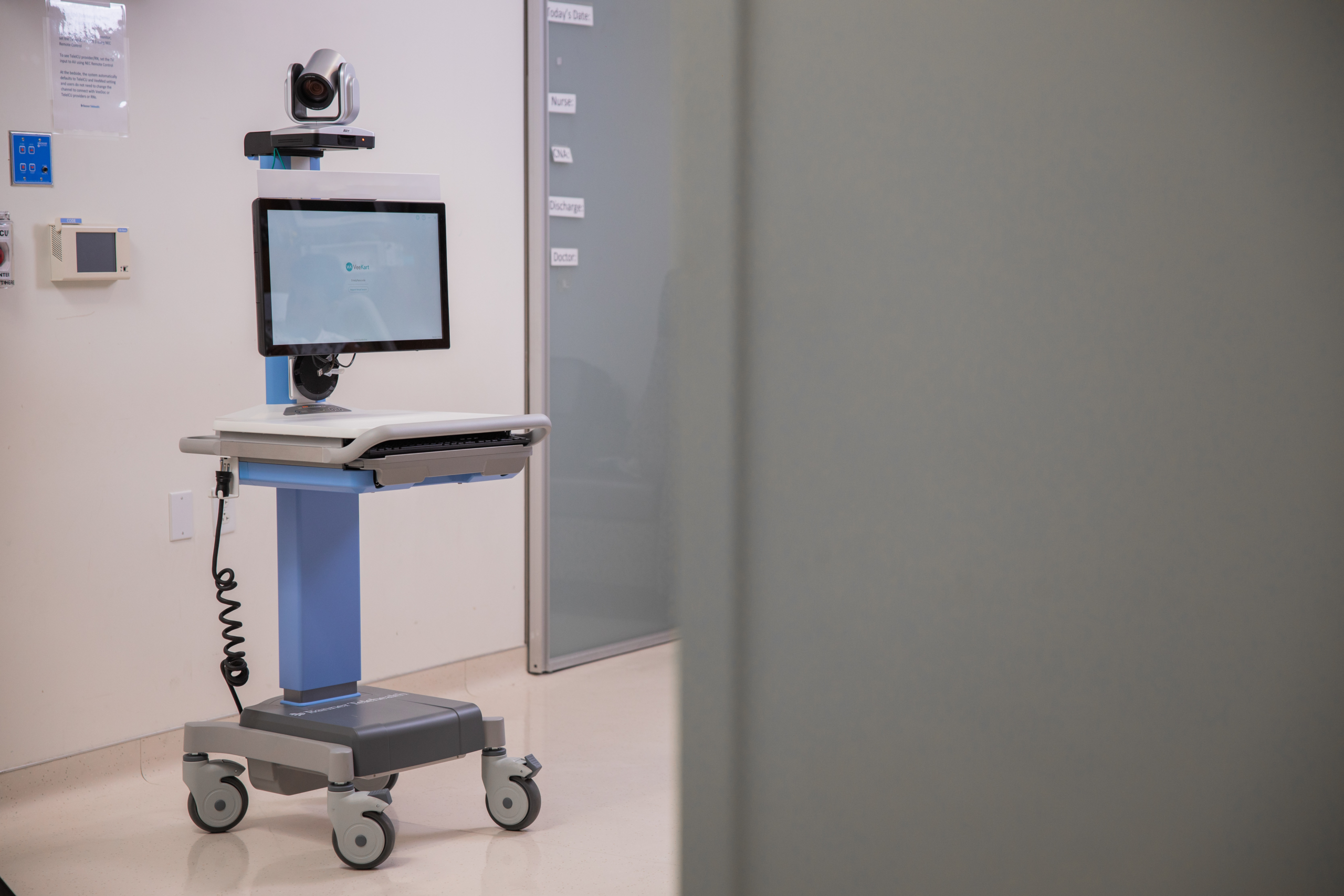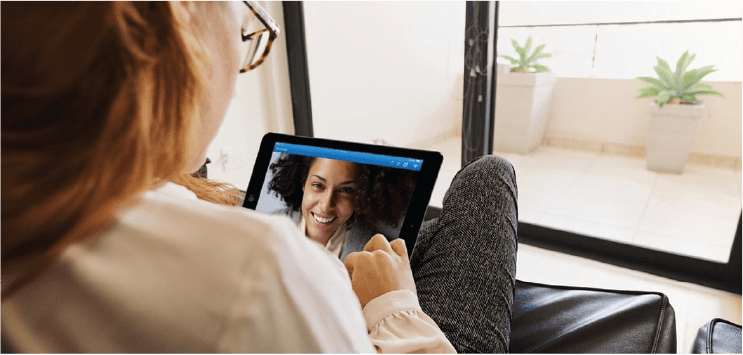Overcoming barriers surrounding access to care is becoming more critical in 2021. According to the US Office of Disease Prevention and Health Promotion, a lack of availability of services is a significant barrier to care. With COVID-19 still ravaging the U.S. and healthcare systems, providing access to quality care is the focus of many hospitals.
If you’re struggling to improve care access at your hospital, there’s good news. A telemedicine cart can help you extend your organization’s reach safely without adding extra headcount.
Telemedicine emerged as the unsung hero of the COVID-19 pandemic, and for good reason. These telehealth platforms can improve access to care, improve revenues, enhance efficiency, and keep care providers and patients safe.
Want to take advantage of these benefits and more? We created this guide to telemedicine carts just for you.
What Is a Telemedicine Cart?
A telemedicine cart is a mobile telehealth platform that enables providers to connect with patients any time, anywhere without having to be physically in the patient’s room. Here’s how it works.
The telemedicine cart comes completely equipped with everything needed for two-way video conferencing, such as a touch screen, HIPAA-compliant audio and video communications capabilities, wireless connectivity, and a backup battery. The cart is mobile, with wheels for easy delivery between patient rooms and hospital floors. Some are also remote-controllable for ultimate flexibility.
Hospitals can set up telemedicine carts as in-patient or out-patient solutions, giving providers the ability to diagnose and treat patients face-to-face, if only virtual. The beauty of the cart is that providers are not limited by location. Even physicians and specialists from other parts of the world can take part in caring for patients remotely.
Once the virtual appointment is over, the cart automatically transmits all patient health data from the visit. A staff member can send this data to specialists, pharmacists, and other hospital caregivers to maintain a responsive continuum of care.
Related: Telemedicine and Critical Access Hospitals: A Practical Solution to Persistent Problems
Are Telemedicine Carts Safe?
Telemedicine carts protect your staff and your patients in three ways:
- They’re purpose-built with antimicrobial properties to help reduce the spread of germs
- Cart computers won’t emit electromagnetic waves that could interfere with medical devices
- The software is HIPAA-compliant and designed to withstand potential security threats
These three safety features make telemedicine carts applicable for both in-patient and out-patient settings.
Beyond cart features, telemedicine carts help hospitals keep their staff and patients safe by limiting physical human interaction in high-risk areas. COVID-19 is a perfect example. Many hospitals have adopted telehealth solutions to facilitate public health mitigation strategies by increasing social distancing. According to the CDC, “They can reduce the strain on healthcare systems by minimizing the surge of patient demand on facilities and reduce the use of PPE by healthcare providers.”
For instance, telehealth services are being used to screen symptomatic patients, identify patients who need additional medical consultation, and for synchronous and asynchronous care.
How Can Hospitals Use Telemedicine Carts?
Hospitals and healthcare systems of all sizes can benefit from telemedicine carts. Whether you need an extra hand with in-patient or remote appointments, want to bring in specialists for enhanced care, or are looking for ways to reduce the transmission of infectious diseases, telemedicine carts have you covered.
Related: Telecardiology Equipment: Bringing Specialists to the Bedside Virtually
In-Patient Telemedicine Care
The telemedicine cart enables contactless delivery of in-patient care. Setting up the technology is simple. A staff member only needs to plug in the cart and log in to enable seamless delivery of virtual care. You can even add in specialists to the care team with the cart’s video conferencing software.
Hospitals often start using telemedicine carts as in-patient solutions. You can trial them with a small group of clinicians first. Then, you can deploy telemedicine carts across your organization and beyond.
Out-Patient Telemedicine Care
With a telemedicine cart, patients can connect with providers remotely after they return home from the hospital or to manage a chronic condition. Providers can also screen and diagnose complex patient cases from a distance. To save time, speed delivery of care, and operate more efficiently, a physician can order labs and tests before the patient ever enters the hospital.
For example, during the pandemic, providers have been using telemedicine carts to do forward triaging. Hospitals can assess patients from a distance before setting an in-person appointment and be certain they have the proper PPE and equipment.
The Benefits of Using a Telemedicine Cart
Studies show that 76% of hospitals have a telehealth solution in place already. That number is expected to grow as more hospitals realize the benefits of telehealth.
Save Time
Providers and patients can save time when using telehealth solutions like telemedicine carts. Research shows that telehealth solutions enable hospitals to reduce door-to-evaluation and door-to-discharge times. And patients save valuable hours spent driving to and from your facility.
Cut Costs
Telemedicine carts may help cut costs for both providers and patients. For example, you can make up for physician shortages without having to transfer patients or hire new staff. Telehealth carts have built-in schedulers, so you won’t need to hire call center staff. Instead, the software matches your request to an on-call telephysician who partners with the provider.
In some cases, telemedicine carts may also help patients cut medical costs. One study found that telehealth patients could reduce time spent in the hospital, saving time and money. Telehealth solutions also result in fewer patient readmissions as patients are more likely to follow care instructions and take their prescribed medications as directed when they have a telehealth provider monitoring their health.
Improve Patient Satisfaction
In a world of value-based care, patient satisfaction translates to your revenues. That’s why improved patient satisfaction is one of the most critical benefits of telemedicine carts.
Telemedicine carts offer patients safe and convenient access to care, both in an inpatient and remote setting. For patients admitted to the hospital, they spend less time waiting for a provider, can see specialized providers who may not be physically in their hospital, and have more regular and responsive care.
Remote telehealth cuts travel times for rural patients. It also provides improved access for disabled individuals. Plus, patients don’t have to wait in line to see a doctor. All of these factors are critical for improving patient satisfaction at your hospital.
Control Infectious Illness
We’ve already mentioned the role telemedicine carts have played in the COVID-19 pandemic. As you can imagine, these proven benefits are applicable in the future for infectious patients.
Forward triaging reduces provider and patient risk of infection. Patients don’t have to come to the hospital unless absolutely necessary. And once patients do come to the hospital, providers can assess patients from another room.
Both of these factors reduce the potential transmission of infection. Telemedicine carts also save providers valuable time since they don’t have to suit up in protective gear to care for patients.
Telehealth Endpoints for Telemedicine Providers
A telemedicine cart is the perfect entry point for hospitals wanting to improve access to care. Whether you want to use them for in-patient or out-patient care, telemedicine carts save you time, cut costs, and up patient satisfaction.
It’s important to consider how you’ll scale the use of your telemedicine cart before you buy. Choose a cart that has the built-in capabilities to grow with your organization.
That’s where VeeOne Health’s VeeKart comes in.
Ready to find out how VeeOne Health’s VeeKart can help your hospital conquer the COVID-19 pandemic and so much more? Request a demo today to see how we can help you transform your patients’ access to care.





